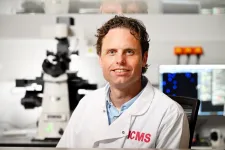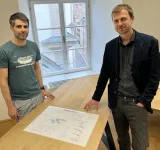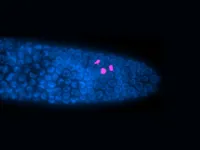(Press-News.org) Neuropathy is a type of chronic pain triggered by nerve injury or certain diseases. It affects millions of people worldwide, significantly deteriorating their quality of life. Neuropathy, for example, might emerge from hurting the sciatic nerve on the lower back or the spinal cord, in diseases like rheumatoid arthritis and diabetes or after chemotherapy drugs. Current therapies attempt to suppress the symptoms with pain medications like opioids, but their efficacy is low, and they carry undesirable side effects.
A group led by researchers at Baylor College of Medicine and University of Alabama at Birmingham took on the challenge of investigating the process that leads to neuropathy with the goal of identifying strategies to prevent or control it. They report in the journal Neuron that the gene Tiam1 is at the core of mechanisms leading to the development and maintenance of neuropathic pain. In animal models of the condition, eliminating the Tiam1 gene or blocking its actions prevented or reversed chronic pain caused by a variety of triggers. The findings open new possibilities for novel therapies to provide much needed relief to patients with this condition.
“Neuropathy is a different type of pain than the pain that acts as a warning system that something has or may injure the body. For instance, if you touch a hot stove, the pain will make you pull away immediately, protecting the body from a serious burn,” said last and co-corresponding author Dr. Kimberley F. Tolias, professor in the departments of neuroscience and biochemistry and molecular biology at Baylor. “Neuropathy, on the other hand, is on-going, long-lasting and not helpful to the body.”
Neuropathy patients experience hypersensitivity or extreme sensitivity to pain. “Situations that are not normally painful, become painful, and those that are a bit painful become very painful,” Tolias said.
Previous studies have shown that pain hypersensitivity emerges from structural and functional changes that occur in the spinal cord. Some of these changes involve alterations in the synapses, the physical connections between neurons, cells that transmit nerve signals. Functionally, the ability to inhibit synapses is reduced while they are more easily excited. Structurally, there is an increase in size and density of the dendritic spines, primary structures involved in establishing synaptic connections. These changes account for the long-term nature of neuropathic pain. However, although the physical and functional changes in the spinal cord are clear, the mechanisms controlling their implementation and persistence in neuropathic pain remained a mystery.
“In this study we discovered that the gene Tiam1, which is known to regulate normal synapse development, also plays a central role in establishing the structural and functional changes in synapses that lead to neuropathy,” Tolias said.
The team showed in multiple animal models that in response to various forms of nerve injury, Tiam1 drove the initiation, transition and maintenance of neuropathic pain and that eliminating the gene in the spinal cord prevented the development of neuropathic pain without eliminating the animals’ ability to feel ‘warning’ pain.
Importantly, treating animals having the condition with antisense oligonucleotides (ASO) that inhibited Tiam1 activity eliminated the structural and functional changes in the spinal cord as well as neuropathic pain. ASOs are small stretches of modified DNA that are commonly used to reduce the amount of a specific protein in the body (Tiam1 in this case) by interfering with the process that produces the protein. ASOs are already in clinical use to treat other diseases.
“We are excited about these findings,” said first and co-corresponding author Dr. Lingyong Li, associate professor of anesthesiology and perioperative medicine at the University of Alabama. “We discovered that Tiam1 is at the core of a mechanism that underlies neuropathic pain triggered by different types of injuries or diseases. Altogether, our results suggest that regulating Tiam1’s activity could provide an effective strategy to treat neuropathic pain in the clinic.”
Other contributors to this work include Qin Ru, Yungang Lu, Xing Fang, Guanxing Chen, Ali Bin Saifullah and Changqun Yao. The authors are affiliated with one or more of the following institutions: Baylor College of Medicine, University of Alabama at Birmingham, Jianghan University – China and the University of Texas MD Anderson Cancer Center.
This work was supported by grants from the Department of Defense W81XWH-20-10790, the National Institutes of Health grant NS124141 and NS062829 and the Mission Connect/TIRR Foundation.
END
Gene Tiam1 orchestrates the development of chronic neuropathic pain
2023-05-04
ELSE PRESS RELEASES FROM THIS DATE:
The future of data storage lies in DNA microcapsules
2023-05-04
Storing data in DNA sounds like science fiction, yet it lies in the near future. Professor Tom de Greef expects the first DNA data center to be up and running within five to ten years. Data won’t be stored as zeros and ones in a hard drive but in the base pairs that make up DNA: AT and CG. Such a data center would take the form of a lab, many times smaller than the ones today. De Greef can already picture it all. In one part of the building, new files will be encoded via DNA synthesis. Another part will contain large fields of capsules, each capsule packed with a file. A robotic arm will remove a capsule, read its contents and place it back.
We’re talking about synthetic ...
Quantum computer in reverse gear
2023-05-04
Today's computers are based on microprocessors that execute so-called gates. A gate can, for example, be an AND operation, i.e. an operation that adds two bits. These gates, and thus computers, are irreversible. That is, algorithms cannot simply run backwards. “If you take the multiplication 2*2=4, you cannot simply run this operation in reverse, because 4 could be 2*2, but likewise 1*4 or 4*1,” explains Wolfgang Lechner, professor of theoretical physics at the University of Innsbruck. If this were possible, however, it would be feasible ...
Seizure discoveries advance efforts to develop better treatments
2023-05-04
New University of Virginia School of Medicine insights into how the brain responds to seizures could facilitate the development of much-needed treatments for the third of patients who don’t respond to existing options.
The research, from the labs of UVA’s Ukpong B. Eyo, PhD, and Edward Perez-Reyes, PhD, suggests that immune cells called microglia play important, beneficial roles in controlling various types of seizures. Prior research had left scientists uncertain whether these cells were helpful or harmful during the brain’s ...
Taylor & Francis set to open over 50 book titles with Knowledge Unlatched
2023-05-04
Taylor & Francis is delighted to announce the results of Knowledge Unlatched (KU) 2023, with support pledged to convert over 50 book titles to open access (OA). Titles to benefit from this support cover a broad range of humanities and social science disciplines as well as key topic areas, including climate change, global health, and gender studies.
Under the KU crowdfunding model, research libraries around the world unite to support the publication costs of new eBooks and enable access for all to important new research. Since 2016, when Taylor & Francis’ partnership with Knowledge Unlatched began, over 100 books have been published OA at no cost ...
Obesity as a risk factor for colorectal cancer underestimated so far
2023-05-04
Obesity is a known risk factor for colorectal cancer. Scientists at the German Cancer Research Center (DKFZ) have now shown that this association has probably been significantly underestimated so far. The reason: many people unintentionally lose weight in the years before a colorectal cancer diagnosis. If studies only consider body weight at the time of diagnosis, this obscures the actual relationship between obesity and colorectal cancer risk. In addition, the current study shows that unintentional weight loss may be an early indicator of colorectal ...
Happy worms have healthy eggs
2023-05-04
Worms might not be depressed, per se. But that doesn’t mean they can’t benefit from antidepressants.
In a new study, Northwestern University researchers exposed roundworms (a well-established model organism in biological research) to selective serotonin reuptake inhibitors (SSRIs), a class of drugs used for treating depression and anxiety. Surprisingly, this treatment improved the quality of aging females’ egg cells.
Not only did exposure to SSRIs decrease embryonic death by more than twofold, it also decreased chromosomal abnormalities in surviving offspring by more than twofold. Under the microscope, ...
New guidance to help diagnose hoarding disorder
2023-05-04
Experts from Anglia Ruskin University (ARU) have published new guidance to help doctors correctly diagnose hoarding disorder.
Hoarding disorder affects around 2% of the population but remains a largely misunderstood mental health condition. It was only added to the International Classification of Diseases in 2019, having previously been classified under Obsessive Compulsive Disorder (OCD).
Published in the British Journal of General Practice, the new guidance was written by Dr Sharon Morein and Dr Sanjiv Ahluwalia of Anglia Ruskin University (ARU) in Cambridge, England, to help health professionals spot the signs of hoarding disorder and intervene.
ARU experts have also organised a free ...
GlyNAC supplementation improves cognitive decline and brain health in aging
2023-05-04
As people get older, they aspire to live healthy lives as free as possible from the natural decline of cognitive abilities that occurs with aging. At Baylor College of Medicine, researchers have been studying the biological underpinnings of age-associated cognitive decline and developing nutritional strategies to promote healthy brain aging.
They report today in the journal Antioxidants that supplementing GlyNAC – a combination of glycine and N-acetylcysteine as precursors of the natural antioxidant glutathione – improved or reversed age-associated cognitive decline in old mice and improved ...
Three NYU faculty elected to the National Academy of Sciences
2023-05-04
Three New York University faculty have been elected to the National Academy of Sciences: Moses Chao, a professor at NYU Grossman School of Medicine; Glennys Farrar, a professor in NYU’s Department of Physics; and Subhash Khot, a professor in NYU’s Courant Institute of Mathematical Sciences. This year’s election of 120 new members and 23 international members were chosen “in recognition of their distinguished and continuing achievements in original research,” the academy announced.
Moses Chau, a professor of cell biology, psychiatry, and neuroscience and physiology and part of ...
Criteria for selecting who can enroll in multiple myeloma clinical trials may exclude patients from racial and ethnic minorities
2023-05-04
(WASHINGTON, May 4, 2023) – Numerous studies have shown that people from racial and ethnic minority groups are underrepresented in clinical trials of new medical treatments for multiple myeloma. A study published today in Blood suggests that, for clinical trials of new treatments for multiple myeloma (a type of blood cancer), one reason for this underrepresentation may be that the parameters set to determine who can – and cannot – enroll in trials disproportionately exclude minority patients.
“Our ...


